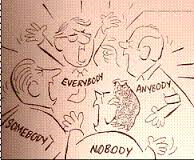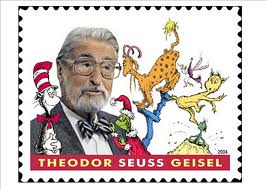Are your Actions Conflicting with your Goals?
By Dani Robbins
Re-published with permission from nonprofit evolution blog
 I’m always fascinated by the number of things people do that are in direct conflict with their goals. My dog does a perfect illustration of this: He gets so excited when we have visitors that he acts inappropriately and gets put outside or crated, which prevents him from meeting his goal of being loved by our visitors. He is not alone. Leaders and organizations do the same thing!
I’m always fascinated by the number of things people do that are in direct conflict with their goals. My dog does a perfect illustration of this: He gets so excited when we have visitors that he acts inappropriately and gets put outside or crated, which prevents him from meeting his goal of being loved by our visitors. He is not alone. Leaders and organizations do the same thing!
This week, since it’s a new year and many people in my personal and professional lives have begun working on new goals, I’ve been thinking about the intent of those goals.
I love goals that are intended to get everyone on the same page and align the work of an organization.
I do not love goals that are intended to motivate people, and I’m not even clear why we would need to do that.
Employee goals intended to motivate don’t make any sense to me and, honestly, I don’t find them motivating. In fact, I find them de-motivating, and also slightly insulting. High performers — a group I like to count myself among — will do their very best every day, aligned with the work they’ve been assigned and the expectations of their position, and not in any way because of the goals they’ve been assigned. They will do their best because it’s who they are and the work ethic they possess. It is our job as leaders to demonstrate our vision and hire, support, groom and develop high performers who can help us reach that vision.
 Let me be very clear, I absolutely and unequivocally believe that leaders must set expectations for staff and also evaluate those staff based on the expectations set. I also believe that the job of the exec is to implement the strategic plan which doubles as their goals. In the absence of a plan, it is the board’s job to work with the exec to set the expectations by which they will evaluate that exec’s performance at the year’s end. Those expectations (call them goals if you must) should not be set to motivate your exec. They should be set to align the work of the organization, ensure everyone is on the same page and provide a process for evaluation. If you have to set goals to motivate your exec, you have the wrong exec.
Let me be very clear, I absolutely and unequivocally believe that leaders must set expectations for staff and also evaluate those staff based on the expectations set. I also believe that the job of the exec is to implement the strategic plan which doubles as their goals. In the absence of a plan, it is the board’s job to work with the exec to set the expectations by which they will evaluate that exec’s performance at the year’s end. Those expectations (call them goals if you must) should not be set to motivate your exec. They should be set to align the work of the organization, ensure everyone is on the same page and provide a process for evaluation. If you have to set goals to motivate your exec, you have the wrong exec.
As leaders, we should all strive to have as many high performers as we can possibly attract and afford. It begs the question: are the goals we are setting for high performers alienating those performers? I think they might be. I’m beginning to believe that employee goals that are intended to motivate people are lowering our standards, teaching to the middle, and working in direct conflict of our actual goals of meeting our missions and achieving our organizations’ visions. You know, I believe that any action, process, policy or procedure that is in conflict with our goal is a bad action, process, policy or procedure. I am starting to believe that goals that are intended to motivate are just that.
Once, many years ago and before I really understood resource development and major donor cultivation, I was running an agency that attracted about $50,000 of contributions from individuals each year. My Board Chair wanted to set a goal for me of $1,000,000. One million dollars! Yes, your math is right and that would have been 20 times the annual giving received by that agency. He called it a stretch goal.
Rather than inspire me to reach that goal, it terrified me -– and not in a good way. How in the world — with no change in staffing, no change in process or a new program or project to announce — was I going to raise 20 times our current contributed income? I wasn’t.
Thankfully, I was able to explain my position and get him to revise my goals. To his credit- and this may have been his intent all along — I ramped up my own knowledge and capacity for raising money and cultivating and retaining major donors giving major gifts.
I did raise that amount and more a few years later, but not because of a goal and not, by any stretch of the imagination, alone. I did it with a change in staffing, a more developed board, several changes in process and a huge project that addressed a significant gap in service that I was committed to rectify.
Wanting something doesn’t make it a good goal. If you set goals, set them to recognize, hire and retain high performers. Set them to align the work of your agency. Set them to have some way to evaluate your executive. Make your goals doable, with systems to support them and a path to achieve them.
Don’t set goals to motivate people! We should not be using goals to motivate. We shouldn’t have to. The work we do and the communities we serve should motivate our team toward greatness. If they don’t, we have built the wrong team and no amount of goal setting is going to rectify that.
What do you think about goals being used to motivate staff? As always, I welcome your insight, feedback and experience. Please share your ideas or suggestions for blog topics and consider hitting the follow button to enter your email. A rising tide raises all boats.


 Good morning! Last week we discussed chapter 14 of
Good morning! Last week we discussed chapter 14 of 
 Work-Life balance is about dividing your time between work and life. Work stays there and your life is over here. The idea of balance looks like the scales of justice, and the two sides (representing work and life) are in perfect balance.
Work-Life balance is about dividing your time between work and life. Work stays there and your life is over here. The idea of balance looks like the scales of justice, and the two sides (representing work and life) are in perfect balance. I used to look at work-life balance through the same lens as my mother-in-law, but a friend of mine helped me change the way I look at these competing things in my life.
I used to look at work-life balance through the same lens as my mother-in-law, but a friend of mine helped me change the way I look at these competing things in my life. As I stewed about this morning’s conversation with my mother-in-law, I started thinking about all of my non-profit friends. I couldn’t think of anyone with perfectly balanced scales, but I could think of lots of non-profit friends who appear happy and fulfilled.
As I stewed about this morning’s conversation with my mother-in-law, I started thinking about all of my non-profit friends. I couldn’t think of anyone with perfectly balanced scales, but I could think of lots of non-profit friends who appear happy and fulfilled. Sometimes you just got nothing. It is late at night, and I have to catch a plane in the early morning. If there is going to be a Tuesday morning DonorDreams blog, then it has to happen right now. Sigh … sometimes you just got nothing! So, during times like this, I look for real experiences to share. So, I thought I’d share a conversation I had last week with a fundraising professional in New Mexico.
Sometimes you just got nothing. It is late at night, and I have to catch a plane in the early morning. If there is going to be a Tuesday morning DonorDreams blog, then it has to happen right now. Sigh … sometimes you just got nothing! So, during times like this, I look for real experiences to share. So, I thought I’d share a conversation I had last week with a fundraising professional in New Mexico. I can’t prove it, but I suspect that executive directors for non-profit organizations are the most under-appreciated bunch of people on the planet. Working for a group of people (e.g. board of directors) compared to one person is difficult, and I think this contributes to my observations pertaining to appreciation. Simply stated I think group dynamics are such that every person thinks someone else is doing the appreciating and recognizing.
I can’t prove it, but I suspect that executive directors for non-profit organizations are the most under-appreciated bunch of people on the planet. Working for a group of people (e.g. board of directors) compared to one person is difficult, and I think this contributes to my observations pertaining to appreciation. Simply stated I think group dynamics are such that every person thinks someone else is doing the appreciating and recognizing. I was running a Boys & Girls Club in Texas, when I was offered the Executive Director position for the Boys & Girls Clubs in Akron, Ohio. I knew the President of the Akron Community Foundation and not another soul in town. Thankfully, my Board had a plan.
I was running a Boys & Girls Club in Texas, when I was offered the Executive Director position for the Boys & Girls Clubs in Akron, Ohio. I knew the President of the Akron Community Foundation and not another soul in town. Thankfully, my Board had a plan. Program officers of foundations are incredibly generous with their time and are interested in learning about your organization. Community leaders, by definition, care about the community. Go talk to them. You will be pleasantly surprised by the number of people who say yes to your request for a meeting.
Program officers of foundations are incredibly generous with their time and are interested in learning about your organization. Community leaders, by definition, care about the community. Go talk to them. You will be pleasantly surprised by the number of people who say yes to your request for a meeting. Figure out the “must attend” event in town, and attend. And when you do, walk around and greet everyone, introduce yourself to people you haven’t been able to get in front of and ask if you can call them for a meeting. Again, you’ll be surprised at the number of people who say yes.
Figure out the “must attend” event in town, and attend. And when you do, walk around and greet everyone, introduce yourself to people you haven’t been able to get in front of and ask if you can call them for a meeting. Again, you’ll be surprised at the number of people who say yes. Many of you probably didn’t notice yesterday that we didn’t publish a blog post at DonorDreams. Yes, it was Thanksgiving, but that wasn’t the reason why we missed a day. The truth of the matter is that I was being treated to a Dallas Cowboys Thanksgiving football game at AT&T stadium.
Many of you probably didn’t notice yesterday that we didn’t publish a blog post at DonorDreams. Yes, it was Thanksgiving, but that wasn’t the reason why we missed a day. The truth of the matter is that I was being treated to a Dallas Cowboys Thanksgiving football game at AT&T stadium. Your non-profit brand is powerful. It is coveted by major corporations. It doesn’t matter if you are a major non-profit juggernaut like Boy Scouts or Girl Scouts or if you’re a teeny-tiny rowboat out there in the vast ocean of non-profit organizations. You are still valued. The mere fact that you are a non-profit organization, regardless of your mission, in and of itself is valued by corporate America.
Your non-profit brand is powerful. It is coveted by major corporations. It doesn’t matter if you are a major non-profit juggernaut like Boy Scouts or Girl Scouts or if you’re a teeny-tiny rowboat out there in the vast ocean of non-profit organizations. You are still valued. The mere fact that you are a non-profit organization, regardless of your mission, in and of itself is valued by corporate America. The following are all facts (OK, they are facts
The following are all facts (OK, they are facts  Have you heard of the “Halo Effect“?
Have you heard of the “Halo Effect“? You may be wondering what I mean by “abusing your non-profit brand“. Here is just a short list of neglectful things:
You may be wondering what I mean by “abusing your non-profit brand“. Here is just a short list of neglectful things: For two days this week, I’ve been holed up in a little room interviewing donors, community leaders, and collaborative partners as part of an organizational assessment project. When you work in a small room for an extended period of time, you tend to notice every little thing. It was during this time that I found inspiration literally painted on the walls, which got me wondering where you and your non-profit organization gets its inspiration?
For two days this week, I’ve been holed up in a little room interviewing donors, community leaders, and collaborative partners as part of an organizational assessment project. When you work in a small room for an extended period of time, you tend to notice every little thing. It was during this time that I found inspiration literally painted on the walls, which got me wondering where you and your non-profit organization gets its inspiration?
 I know that today’s post is a little different from the typical DonorDreams blog post, but working in that small room surrounded by those quotations got me wondering:
I know that today’s post is a little different from the typical DonorDreams blog post, but working in that small room surrounded by those quotations got me wondering: As I said in an earlier post this week, I am currently in Reno, Nevada at Boys & Girls Clubs of America’s Pacific Leadership Conference. The conference is being held at Silver Legacy Resort & Casino. Of course, in order to get from the hotel to the conference sessions, you need to walk through the casino where you are bombarded by all sorts of “shiny objects”.
As I said in an earlier post this week, I am currently in Reno, Nevada at Boys & Girls Clubs of America’s Pacific Leadership Conference. The conference is being held at Silver Legacy Resort & Casino. Of course, in order to get from the hotel to the conference sessions, you need to walk through the casino where you are bombarded by all sorts of “shiny objects”. In an effort to make the time pass more quickly, I started making a list. Admittedly, I started thinking way outside of the box, but here is some of what I came up with:
In an effort to make the time pass more quickly, I started making a list. Admittedly, I started thinking way outside of the box, but here is some of what I came up with:




